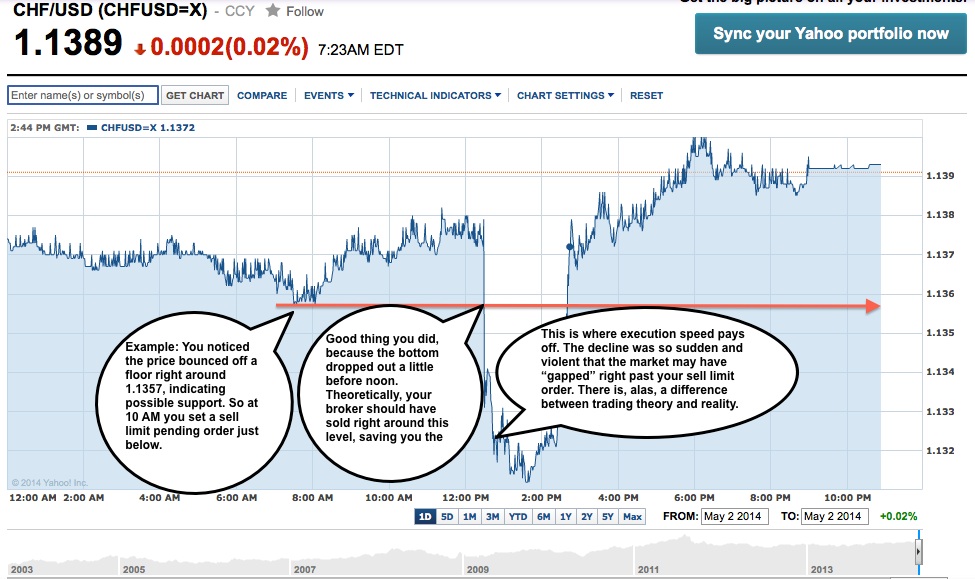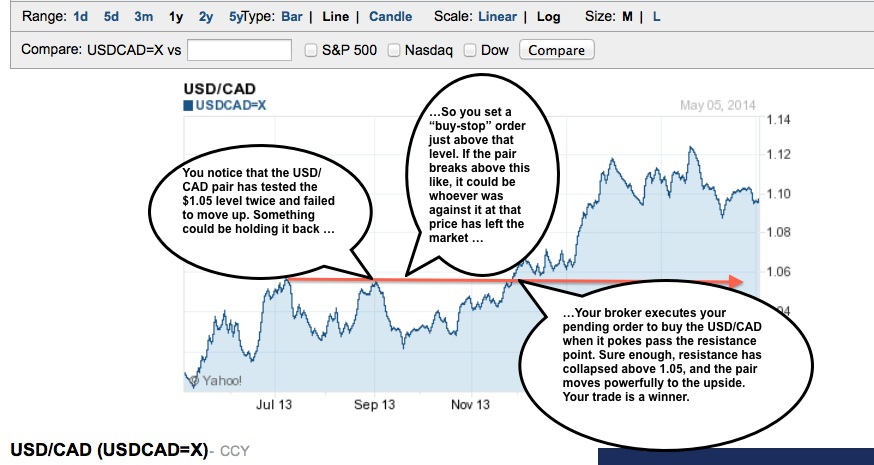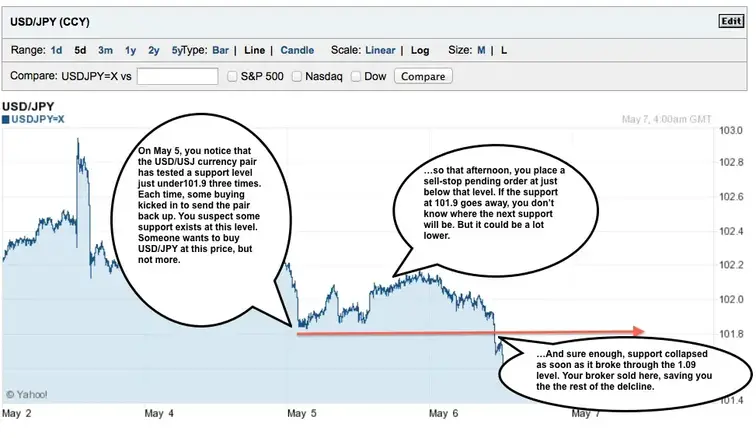Forex Pending Order Trading Strategy: Planning Ahead For Protection and Profit

This guide is all about how Forex pending orders work in trading. The currency markets operate 24/7. That’s a lot more than any of us can remain sitting at our computer screens, obsessively monitoring each price tick up and down for all our currency positions and everything we want to be in.
That’s where pending orders come in. Using pending orders, you can give your broker instructions on when to buy or sell even when you can’t be on the computer yourself. You can use these pending orders to protect yourself by automatically exiting your position during a downswing that happens even when you aren’t looking.
You can also use them to set yourself up to profit if the price reaches an advantageous level for buying when you are away from your keyboard.
Table of Contents
Introduction: The Basics Of Pending Orders

There are two basic types of market orders: “Buy” and “Sell.”
So far, so good, right?
These two basic types of orders – to buy or sell at current market prices – are called market orders.
But not everything is always so straightforward. Sometimes, as a trader, you may want to have a ‘standing order’ to sell under specific circumstances or to buy under specific circumstances, without further intervention from you.
These orders are known as “pending orders.” You enter a pending order, and you specify what you want your broker to do if a given security or currency hits a certain price and passes it, either on the way up or on the way down.
In theory, your pending orders help protect you from a market meltdown when you have an open position and you happen to be away from your terminal or otherwise out of touch with your broker and can’t place the order, personally. You can also read about money management techniques in Forex trading for better trading.
Types of Pending Orders In Forex
There are four basic types of pending orders common in Forex trading:
Buy limit
An order to buy a security if the security reaches or goes below a certain price, selected by you. This helps protect you against a sudden price decline. You might set this limit just below an apparent support level, on the theory that if this support level is broken, there’s no telling how far the price may fall until it reaches a new level of support.
Sell limit
An order to sell a security if it reaches or rises above a specified price. This order helps you take some profits off the table. You might set up a sell limit at or above your target price for a security. This is the point at which you believe a security is fully valued.
Buy stop
Also called a “stop order to buy.” This is an order to buy a security if it reaches a price at or above a certain price. You might set this just above a key point of resistance, on the technical trading theory that if a security breaks through this resistance point, it is set up for a bullish run to the upside.
Sell stop
A standing order to sell a security if the price plunges below the current asking point. You might place this order just below a key level of support, on the technical theory that if whatever had been kicking in at that price to buy the security in the past is no longer there, the security is set up for a bearish run. You want to be out of the position, or even take a short position, which allows you to benefit from price declines.
Executing Forex Pending Orders
The precise procedure for plotting and/or entering them will vary depending on your trading software and brokerage.
Caution: These orders aren’t holy writ: If you place an order into a market that is falling or rising fast, and isn’t very liquid, you could see the market skip right past your stops or limit orders.
The faster your brokers’ execution speed is, the more likely they’ll be able to execute your trade at your requested price. But they have to do it by matching your order up with a willing counter-party. There is no guarantee that someone will be out there wanting to buy what you’re selling at any given price point.
Your account could suffer losses because prices move beyond your stop and limit orders before your broker is able to execute the order. In other words, your pending orders are only as good as your broker’s execution ability. That’s not much of an issue in normal times – unless you’re trading on very short-term movements and heavily leveraged, or both.
But it is a big issue in times of great volatility and uncertainty when bid-ask spreads can be very wide. For more information, read our ultimate broker guide.
Clear as mud?
Forex Pending Order Examples
Let’s look at a few examples from the charts we created:

If your pending order worked, it saved your bacon! But sometimes markets overwhelm limit orders and other pending orders, just by moving too far, too fast, for the broker to match you up with a willing counterpart at that price.
Let’s move on to another example, the sell limit order, sometimes used as a ‘profit-taking’ tactic. That is, once in a while, the trader wants to be sure to take the money and run before the market can turn against him:

These two are defensive moves, designed to help limit your risk. The next two pending orders play offense. They are designed to put you in the way of a trade you have reason to believe has a better than even chance of being successful. (If you think there are sure things in Forex, put your money in CDs).
Here is the buy stop, or the ‘stop order to buy,’ illustrated with an actual chart:

The last common pending order is the sell stop. Here’s how it might work, using a real chart:

The Sell Stop can help protect you from sudden declines in the price of a security or currency pair. If you enjoyed this article, be sure to check out our forex income article.
Pending Order Trading Strategy FAQs
What does a pending order mean?
A pending order in trading refers to an order that has been placed but has not yet been executed. Traders use pending orders to specify conditions under which they want to enter or exit a trade.
These conditions typically include a specific price at which they want the trade to be executed. Pending orders remain active until they are triggered by reaching the specified price or until the trader cancels them.
In essence, a pending order allows traders to automate their trading strategy by pre-defining entry and exit points based on their analysis and market expectations.
How long do pending trades take?
The duration it takes for a pending trade to execute can vary depending on several factors:
Market Conditions: If the market quickly reaches the price specified in your pending order, it can execute almost instantly. However, if the market moves away from your specified price, the order may remain pending until conditions are met.
Order Type: The type of pending order you’ve placed also influences the execution time. For example, a market order will execute immediately if the specified price is available, while a limit order may take longer if the market doesn’t reach your specified price.
Liquidity: Highly liquid markets tend to execute orders more quickly because there are more buyers and sellers available. Less liquid markets may take longer to execute pending orders, especially if the specified price is far from the current market price.
Trading Session: Depending on the time of day and trading session, market activity can vary, affecting the speed of order execution.
In general, pending trades can execute anywhere from seconds to hours or even longer, depending on market conditions and your specific trading parameters.
What is the difference between a pending order and a market order?
The key difference between a pending order and a market order lies in when they’re executed and at what price.
A market order is executed immediately at the current market price. When you place a market order, you’re essentially saying, “I want to buy or sell this asset right now, at whatever the going rate is.”
On the other hand, a pending order allows you to specify conditions under which you want your trade to be executed. You set a price at which you’re willing to buy or sell, and the order remains pending until the market reaches that price. So, it’s like saying, “I want to buy/sell this asset, but only if it reaches a certain price.”
In summary, market orders are executed instantly at the current market price, while pending orders wait until specific conditions are met before being executed.
What happens to Forex pending orders after the market closes?
In Forex trading, pending orders usually stay put even after the market calls it a day. Forex doesn’t really have a closing time like the stock market does. It’s open 24/5. So, if you’ve got pending orders set up, they’ll hang around until they’re triggered, cancelled, or they reach their expiration time, just like you’ve set them up.
This may vary by broker, some brokers may cancel pending orders that don’t get filled before the weekend close.
Trading conditions can shift between different sessions, which might affect how and when your pending orders get executed.
Can I place a pending order before the market opens?
Many brokerage platforms allow you to place pending orders before the market opens. These are usually known as “pre-market orders” or “extended-hours orders.” Just keep in mind that not every broker offers this option, and trading during pre-market hours comes with its own set of limitations and risks.
It’s a good idea to reach out to your broker to understand their specific policies and procedures for placing orders before the market opens.
Conclusion: Pending Orders In Forex
Understanding Forex Pending orders is imperative for every trader. With Forex markets buzzing 24/7, pending orders become your trusty sidekick, helping you make moves even when you’re not glued to your screen. Think of pending orders as your trading assistant, ready to act on your behalf when certain conditions are met.
By mastering the execution of pending orders, you’re not just trading – you’re navigating the Forex world with finesse, making savvy decisions that can help you ride the waves and come out on top.
Thank you for reading!
Please leave a comment below if you have any questions on how to use pending orders for protection and profit!
Also, please give this topic a 5 star rating and share on social media if you enjoyed it!
-Jason Van Steenwyk







I do agree with all the ideas you have presented in your post. They’re really convincing and will definitely work. Still, the posts are too short for newbies. Could you please extend them a little from next time? Thanks for the post.